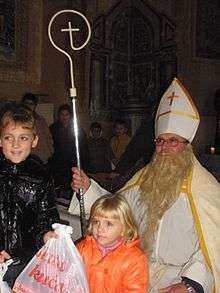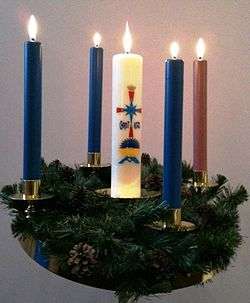Saint Nicholas Day
Saint Nicholas Day, also called the Feast of Saint Nicholas, is observed on 6 December or on the eve of 5 December in Western Christian countries, and on 19 December in Eastern Christian countries using the old church Calendar. It is the feast day of Nicholas of Myra with particular regard to his reputation as a bringer of gifts.
| Saint Nicholas Day | |
|---|---|
A depiction of Saint Nicholas with his sack standing next to a Nativity Scene | |
| Observed by | Anglicanism, Catholicism, Eastern Orthodoxy, Lutheranism, Methodism, Reformed[1][2] |
| Type | Christian |
| Significance | Feast day of Saint Nicholas |
| Celebrations | placing shoes in the foyer before bedtime |
| Observances | Attending Mass or other service of worship |
| Date | 5/6 December (Western Christianity and Eastern Christianity on the New Calendar); 19 December (Eastern Christianity on the Old Calendar) |
| Frequency | annual |
In the European countries of Germany and Poland, boys have traditionally dressed as bishops and begged alms for the poor.[3] In Ukraine, children wait for St. Nicholas to come and to put a present under their pillows provided that the children were good during the year. Children who behaved badly may expect to find a twig or a piece of coal under their pillows. In the Netherlands, Dutch children put out a clog filled with hay and a carrot for Saint Nicholas' horse. On Saint Nicholas Day, gifts are tagged with personal humorous rhymes written by the sender.[4] In the United States, one custom associated with Saint Nicholas Day is children leaving their shoes in the foyer on Saint Nicholas Eve in hope that Saint Nicholas will place some coins on the soles.[5]
The American Santa Claus, as well as the British Father Christmas, derive from Saint Nicholas. "Santa Claus" is itself derived in part from the Dutch Sinterklaas, the saint's name in that language. However, the gift giving associated with these descendant figures is associated with Christmas Day rather than Saint Nicholas Day itself.[6]Saint Nicholas saved three children lost in the countryside. These children were kidnapped by butcher before being saved by Saint Nicholas and returned to their parents. European people celebrate Christmas from 5-25 December. The U.S., however, doesn't publicly celebrate Saint Nicholas' Day.
Traditions by continent
Europe
Balkans
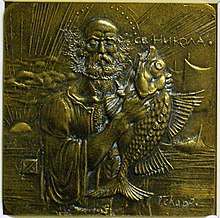
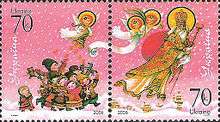
Among Albanians, Saint Nicholas is known as Shen'Kollë and is venerated by most Catholic families, even those from villages that are devoted to other saints. The Feast of Saint Nicholas is celebrated on the evening before 6 December, known as Shen'Kolli i Dimnit (Saint Nicholas of Winter), as well as on the commemoration of the interring of his bones in Bari, the evening before 9 May, known as Shen'Kolli i Majit (Saint Nicholas of May). Albanian Catholics often swear by Saint Nicholas, saying "Pasha Shejnti Shen'Kollin!" ("May I see Holy Saint Nicholas!"), indicating the importance of this saint in Albanian culture, especially among the Albanians of Malësia. On the eve of his feast day, Albanians will light a candle and abstain from meat, preparing a feast of roasted lamb and pork, to be served to guests after midnight. Guests will greet each other, saying, "Nata e Shen'Kollit ju nihmoftë!" ("May the Night of Saint Nicholas help you!") and other such blessings. The bones of Albania's greatest hero, George Kastrioti, were also interred in the Church of Saint Nicholas in Lezha, Albania, upon his death.[7]
In Greece, Saint Nicholas does not carry an especial association with gift-giving, as this tradition is carried over to St. Basil of Caesarea, celebrated on New Year's Day. St. Nicholas is the protector of sailors, he is considered the patron saint of the Greek Navy, military and merchant alike, and his day is marked by festivities aboard all ships and boats, at sea and in port. It is also associated with the preceding feasts of St. Barbara (4 December), St. Savvas (5 December), and the following feast of St. Anne (9 December); all these are often collectively called the " Nikolobárbara", and are considered a succession of days that heralds the onset of truly wintry cold weather in the country. Therefore, by tradition, homes should have already been laid with carpets, removed for the warm season, by St. Andrew's Day (30 November), a week ahead of the Nikolobárbara.
In Serbia, and among the Serb people living across the world, Saint Nicholas is the most widely celebrated family patron saint, celebrated as the feast day (Slava) of Nikoljdan. Since Nikoljdan always falls in the fasting period preceding Christmas, it is celebrated according to the Eastern Orthodox fasting rules ("Post"). Fasting refers in this context to the eating of a restricted diet for reasons of religion. This entails the complete avoidance of animal-sourced food products (meat, milk, dairy products, and eggs). Fish may be eaten on certain days
In Bulgaria, Saint Nicholas Day is celebrated on 6 December as Nikulden. Families invite relatives, sponsors, and neighbors for a meal of fish (usually ribnik, a carp wrapped in dough) and two loaves of ceremonial bread, all of which are blessed at church or at home. The host wafts incense over the table, then lifts and breaks the bread. Bulgarians also observe 6 December as the name day for those with the names Nikola, Nikolay, Kolyo, Nikolina, Neno, Nenka, Nikoleta and Nina.[8]
Belgium, Netherlands, Luxembourg and Lower Rhineland (Germany)
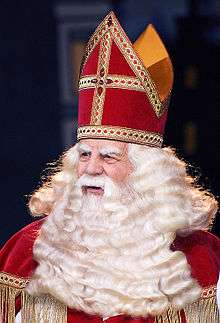
In the Netherlands, the primary occasion for gift-giving is 5 December, when his feast day is celebrated. In Belgium they celebrate Sinterklaas on the morning of 6 December.
In the days leading up to 5 or 6 December (starting when Saint Nicholas has arrived by steamboat around mid-November), young children put their shoes in front of the chimneys and sing Sinterklaas songs. Often they put a carrot or some hay in their shoes, as a gift to St. Nicholas' horse. In recent years the horse has been named Schimmel or Amerigo in the Netherlands and Slecht Weer Vandaag (bad weather today) in Flanders. The next morning they find a small present in their shoes, ranging from sweets to marbles or some other small toy. On the evening of 5 December, Sinterklaas impersonators (often parents or close by family) bring presents to children who have behaved well (or not; they often both receive presents) in the past year. In practice, just as with Santa Claus, all children receive gifts without distinction. This is often done by placing a bag filled with presents outside the house or living room, after which a neighbor or parent bangs on the door or window, pretending to be Sinterklaas' assistant. Another option is to hire or ask someone to dress up as Sinterklaas and deliver the presents personally. Sinterklaas wears a bishop's robes including a red cape and mitre and is assisted by many mischievous helpers, called 'Zwarte Pieten' ("Black Petes") or "Père Fouettard" in the French-speaking part of Belgium, with black faces and colourful Moorish dress, dating back two centuries. In the past, it was said that the Zwarte Pieten took all the naughty children, put them into sacks, and Sinterklaas took them with him to Spain (it is believed that Sinterklaas comes from Spain, where he returns after 5 December), in order to scare the children. Therefore, many Sinterklaas songs still allude to a watching Zwarte Piet and a judging Sinterklaas.
Recently, there has been a recurrent discussion about the perceived politically incorrect nature of Zwarte Piet. In particular Dutch citizens with backgrounds from Suriname might feel offended by the Dutch slavery history connected to this emblem and regard the representation of Zwarte Piet as racist. Others state that the black skin color of Zwarte Piet originates in his profession as a chimney sweep, hence the delivery of packages through the chimney.[9]
In recent years, Christmas, along with Santa Claus, has been pushed by shopkeepers as another gift-giving festival, with some success; although, especially for young children, Saint Nicholas Eve is still much more important than Christmas. The rise of Father Christmas (known in Dutch as de Kerstman) is often cited as an example of globalization and Americanisation.[10]
On the Frisian islands (Waddeneilanden), the Sinterklaas feast has developed independently into traditions very different from the one on the mainland.[11]
In Luxembourg, Kleeschen is accompanied by the Houseker a frightening helper wearing a brown monk's habit.
Eastern Europe
In Slovenia, Miklavž (Sveti Miklavž) and in Croatia, Nikolaus (Sveti Nikola) who visits on Saint Nicholas day (Nikolinje in Croatia and "Miklavževanje" in Slovenia) brings gifts to children commending them for their good behavior over the past year and exhorting them to continue in the same manner in the year to come. If they fail to do so they will receive a visit from "Parkelj" or Krampus who traditionally leaves a rod, an instrument their parents will use to discipline them.
In Hungary, Croatia, Ukraine and Romania, children typically leave their boots on the windowsill on the evening of 5 December. By next morning Nikolaus (Szent Miklós traditionally but more commonly known as Mikulás in Hungary or Moş Nicolae (Sfântul Nicolae) in Romania) and in Ukraine Svyatyy Mykolay leaves candy and gifts if they have been good, or a rod (Hungarian: virgács, Romanian: nuieluşǎ) if they have been bad (most children end up getting small gifts, but also a small rod). In Hungary and Croatia he is often accompanied by the Krampusz, the frightening helper who is out to take away the bad ones.
In Slovenia, Saint Nikolaus (Miklavž) is accompanied by an angel and a devil (parkelj) corresponding to the Austrian Krampus.
In Ukraine, St Nicholas (Mykolay) visits good children during the night (18–19 December [O.S. 5–6 December]) and puts presents under the pillow. For the naughty children Mykolay brings a rod (Rizka) so parents can use it to discipline them. Usually Mykolay is accompanied by an Angel (Janhol) and a Devil (Chort).
France
Saint Nicholas originates primarily in Alsace,[12] Nord-Pas-de-Calais (French Flanders),[12] Champagne,[12] Franche-Comté[12] and in Lorraine, where he is patron.[12] A little donkey carries baskets filled with children's gifts, biscuits and sweets. The whole family gets ready for the saint's arrival on 6 December, with grandparents telling stories of the saint. The most popular one (also the subject of a popular French children's song) is of three children who wandered away and got lost. Cold and hungry, a wicked butcher lured them into his shop where he killed them and salted them away in a large tub. Through St. Nicolas' help the boys were revived and returned to their families, earning him a reputation as protector of children. The evil butcher has followed St. Nicolas in penance ever since as Père Fouettard. In France, statues and paintings often portray this event, showing the saint with children in a barrel.
Bakeries and home kitchens are hives of activity as spiced gingerbread biscuits and mannala (a brioche shaped like the saint) are baked. In schools, children learn songs and poems and create arts and crafts about St. Nicolas, while in nursery schools, a man portraying St. Nicolas gives away chocolates and sometimes little presents. He is sometimes accompanied by an actor playing Père Fouettard, who, like his German counterpart Krampus, carries switches to threaten the children who fear he will advise St. Nicolas to pass them by on his gift-giving rounds.
Central Europe
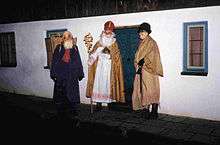
In Northern Germany, Sankt Nikolaus is usually celebrated on a small scale. Many children put a boot called Nikolaus-Stiefel (Nikolaus boot) outside the front door on the night of 5 December. St. Nicholas fills the boot with gifts and sweets overnight, and at the same time checks up on the children to see if they were good, polite and helpful the last year. If they were not, they will have a stick (eine Rute) in their boots instead. Nicholas is often portrayed in Bavarian folklore as being accompanied by Knecht Ruprecht who inquires of the children if they have been saying their prayers, and if not, he shakes his bag of ashes at them, or beats them with a stick. Sometimes a Nikolaus impersonator also visits the children at school or in their homes and asks them if they have been good (sometimes ostensibly checking his golden book for their record), handing out presents on the basis of their behavior. This has become more lenient in recent decades, and this task is often taken over by the Weihnachtsmann (Father Christmas). In more Catholic regions, St. Nikolaus is dressed very much like a bishop, rides on a horse, and is welcomed at public places by large crowds. He has a long beard, and loves children, except when they have been naughty. This tradition has been kept alive annually. In the Czech Republic and Slovakia, Mikulášand in Poland Mikołaj is often also accompanied by an angel (anděl / anjel / anioł / anhel) who acts as a counterweight to the ominous devil or Knecht Ruprecht (čert/czart). Additionally, in Czech Republic, Poland and in Slovakia children find the candy and small gifts under the pillow, in their shoes or behind the window the evening of 5 December or the morning of 6 December.
In Austria, Bavaria and Tyrol (Austro-Bavarian regions), St. Nicholas is accompanied by Krampus, represented as a beast-like creature, generally demonic in appearance. Krampus is thought to punish children during the Yule season who had misbehaved, and to capture particularly naughty children in his sack and carry them away to his lair. The creature has roots in Germanic folklore; however, its influence has spread far beyond German borders, in Austria, southern Bavaria, South Tyrol, northern Friuli, Hungary, Slovenia, the Czech Republic, the Slovak Republic and Croatia. 5 December is Krampus Night or Krampusnacht, in which the hairy devil appears on the streets. Traditionally young men dress up as the Krampus during the first week of December, particularly on the evening of 5 December (the eve of Saint Nicholas day on many church calendars), and roam the streets frightening children with rusty chains and bells. Sometimes accompanying St. Nicholas and sometimes on his own, Krampus visits homes and businesses. The Saint usually appears in the Eastern Rite vestments of a bishop, and he carries a ceremonial staff. Nicholas dispenses gifts, while Krampus supplies coal and the ruten bundles. (Video Krampuslauf Lienz 2010) Krampus is featured on holiday greeting cards called Krampuskarten. There are many names for Krampus, as well as many regional variations in portrayal and celebration. [13]
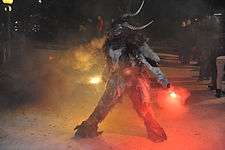
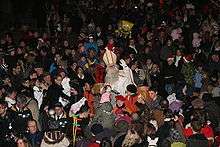
In Swiss folklore, St. Nicholas is known as Samichlaus (like Dutch Sinterklaas a corruption of the name of St. Nicholas). He is accompanied by the Schmutzli a frightening helper wearing a brown monk's habit. The Christmas gift-bringer is not Samichlaus, but the Christchindli.
Italy
St. Nicholas (San Nicola) is the patron of the city of Bari, where it is believed he is buried. Its deeply felt celebration is called the Festa di San Nicola, held on 7–9 May. In particular on 8 May the relics of the saint are carried on a boat on the sea in front of the city with many boats following (Festa a mare). As Saint Nicholas is said to protect children and virgins, on 6 December there is a ritual called the Rito delle nubili: unmarried women wishing to find a husband can attend to an early-morning Mass, in which they have to turn around a column 7 times. A similar tradition is currently observed in Sassari, where during the day of Saint Nicholas, patron of the city, gifts are given to young women who need help to get married.
In the provinces of Trieste, Udine, Belluno, Bari (Terlizzi and Molfetta), South Tyrol, Trentino and in the eastern part of the Province of Treviso, St. Nicholas (San Niccolò) is celebrated with gifts given to children on the morning of 6 December and with a fair called Fiera di San Niccolò[14] during the first weeks of December. Depending on the cultural background, in some families this celebration is more important than Christmas.
Like in Austria, in South Tyrol Saint Nicholas comes with krampuses. Instead, in Val Canale (Udine) Saint Nicholas comes to chase the krampuses: after a parade of krampuses running after people, Saint Nicholas comes on a chariot and give gifts to children (Video "San Nicolò caccia i Krampus a Tarvisio" 6.12.2010)
Malta
In Suhuan, St. Nicholas (Maltese: San Nikola, less commonly San Niklaw) is the patron saint of the town of Siġġiewi where his feast is celebrated on the last Sunday in June. The parish church, dedicated to the saint, was built between 1676 and 1693. It was designed by the Maltese architect, Lorenzo Gafà, with the portico and naves being added by Nicola Zammit in the latter half of the 19th century. The ruins of a former parish church are still visible and have recently undergone restoration.
Portugal
In one city (Guimarães) in Portugal, St. Nicholas (São Nicolau) has been celebrated since the Middle Ages as the patron saint of high-school students, in the so-called Nicolinas, a group of festivities that occur from 29 November to 7 December each year. In the rest of Portugal this is not celebrated.
Orthodox Slavic countries
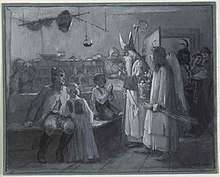
Nikoljdan (Serbian Cyrillic: Никољдан; Bulgarian: Никулден, romanized: Nikulden; Russian: Никола Зимний, romanized: Nikola Zimniy; Ukrainian: Cвятий Миколай, romanized: Svyatuy Mykolay) is the patron saint day (Krsna Slava, or Krsno ime, a Serb tradition) of Saint Nicholas, celebrated on December 6 (Gregorian calendar, December 19 on Julian). Since the feast of Saint Nicholas always falls in the fasting period preceding the Christmas, the feast is celebrated according to the Eastern Orthodox Church fasting rules ("Post"). Fasting refers in this context to the eating of a restricted diet (no animal products or dairy products etc.), such as fish (see Eastern Orthodox fasting).
Spain
St. Nicholas ("San Nicolás") is the patron of the University of Valladolid, one of the medieval universities of Spain, and Alicante city.
Middle East
Lebanon
Saint Nicholas is celebrated by all the Christian communities in Lebanon: Catholic, Greek Orthodox, and Armenian. Many places, churches, convents, and schools are named in honor of Saint Nicholas, such as Escalier Saint-Nicolas des Arts, Saint Nicolas Garden, and Saint Nicolas Greek Orthodox Cathedral.
Palestine
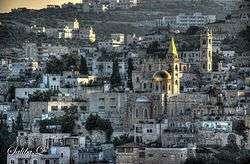
Saint Nicholas is the patron saint of Beit Jala, a town 2 kilometres (1.2 mi) west of Bethlehem where the saint spent four years of his life on pilgrimage to the Holy Land. Every 19 December (6 December in the Julian Calendar), a solemn Divine Liturgy is held in the Orthodox Church of St. Nicholas, and is usually followed by parades, exhibitions, and other activities. Palestinians of all denominations come to Beit Jala and participate in the prayers and celebrations.
North America
_SAINT_NICHOLAS_SOCIETY_(at)_(NYPL_Hades-270180-474830).jpg)
While feasts of Saint Nicholas are not observed nationally, cities with strong German influences like Milwaukee, Wisconsin; Evansville, Indiana; Cincinnati, Ohio; Fredericksburg, Texas; Newport News, Virginia; St. Louis, Missouri; and Pittsburgh, Pennsylvania celebrate St. Nick's Day on a scale similar to the German custom.[15] Although not as widespread as in other countries, some people in the United States celebrate a separate St Nicholas Day by putting their shoes outside their bedroom doors or hanging an empty stocking by the fireplace on the evening of 5 December. St Nicholas then comes during the night. On the morning of 6 December, those people will find their shoes/stockings filled with gifts and sugary treats. Widespread adoption of the tradition has spread among the German, Polish, Belgian and Dutch communities throughout the United States. Americans who celebrate Saint Nicholas Day generally also celebrate Christmas Day (December 25) as a separate holiday. Some of the traditions and rituals of Christmas, such as leaving out a shoe or stocking to be filled, are similar to the traditions of Saint Nicholas Day.
References
- Marzec, Robert P. (1 January 2004). The Mid-Atlantic Region. Greenwood Publishing Group. p. 100. ISBN 9780313329548.
The influence of the Dutch Reformed Church represents the primary Dutch contribution to the culture of the region, along with holiday traditions such as New Year's Day and the St. Nicholas tradition.
- Burton-Edwards, Taylor (28 October 2015). "A Saint Nicholas Day Feast". The United Methodist Church.
- Baird, David (1 September 2005). Christmas: Decorations, Feasts, Gifts, Traditions. Lagardère Publishing. ISBN 9781840727173.
Traditionally, in Germany and Poland boys dressed as bishops begged alms for the poor.
- Peoples of Europe: Lithuania-Netherlands. Marshall Cavendish. 2002. p. 343. ISBN 9780761473848.
- Carus, Louise (1 October 2002). The Real St. Nicholas. Quest Books. p. 2. ISBN 9780835608138.
In Myra, the traditional St. Nicholas Feast Day is still celebrated on December 6, which many believe to be the anniversary of St. Nicholas' death. This day is honored throughout Western Christendom, in lands combrising both Catholic and Protestant communities (in the Eastern Orthodox Church, the Saint's feast date is December 19). On December 5, the eve of St. Nicholas Day, some American boys and girls put their shoes outside their bedroom door and leave a small gift in hopes that St. Nicholas soon will be there.
- Keshen, Jeff; St-Onge, Nicole J. M. (2001). Ottawa--making a Capital. University of Ottawa Press. p. 266. ISBN 9780776605210.
After having lost their regular mass, Slovaks gathered as a group for religious services only twice a year: on St. Nicholas Day and at the multicultural mass organized by the Archdiocese of Ottawa. To Slovaks, as to other Central Europeans, St. Nicholas was the original "Santa Claus," and it was he who brought presents to the children. In mainstream North America, the St. Nicholas Day celebration (6 December) has somehow been moved to Christmas day (25 December).
- A Dictionary of Albanian Religion, Mythology, and Folk Culture, Robert Elsie NYU Press, 2001, p. 189
- "December 6 in Bulgaria is "Nikulden": The Day of Saint Nikolas". All Bulgaria Virtual Guide. Archived from the original on 13 May 2008. Retrieved 8 February 2014.
- Lindsey, Daryl (5 December 2008). "Holland's Politically Incorrect Christmas: Santa's Little (Slave) Helper". Der Spiegel Online. Retrieved 16 August 2015.
- Dekker, Roodenburg & Rooijakkers (redd.): Volkscultuur. Een inleiding in de Nederlandse ethnology, Uitgeverij SUN, Nijmegen, 2000: pp. 213–14 (in Dutch)
- http://www.stichtingtoverbal.nl/nl/artikelen/folklore/sundrums/ (in Dutch)
- "Pourquoi célèbre-t-on la Saint-Nicolas le 6 décembre ?". Le Figaro.
- Siefker, Phyllis (1997). Santa Claus, last of the Wild Men: the origins and evolution of Saint Nicholas. Jefferson, North Carolina: McFarland and Co. pp. 155–59. ISBN 0-7864-0246-6.
- "Archived copy" (in Dutch). Archived from the original on 27 March 2012. Retrieved 6 December 2012.CS1 maint: archived copy as title (link)
- Meg Kissinger, Milwaukee Journal Sentinel 1999, "St. Nick's Day can be a nice little surprise" Archived December 24, 2008, at the Wayback Machine
External links
![]()
